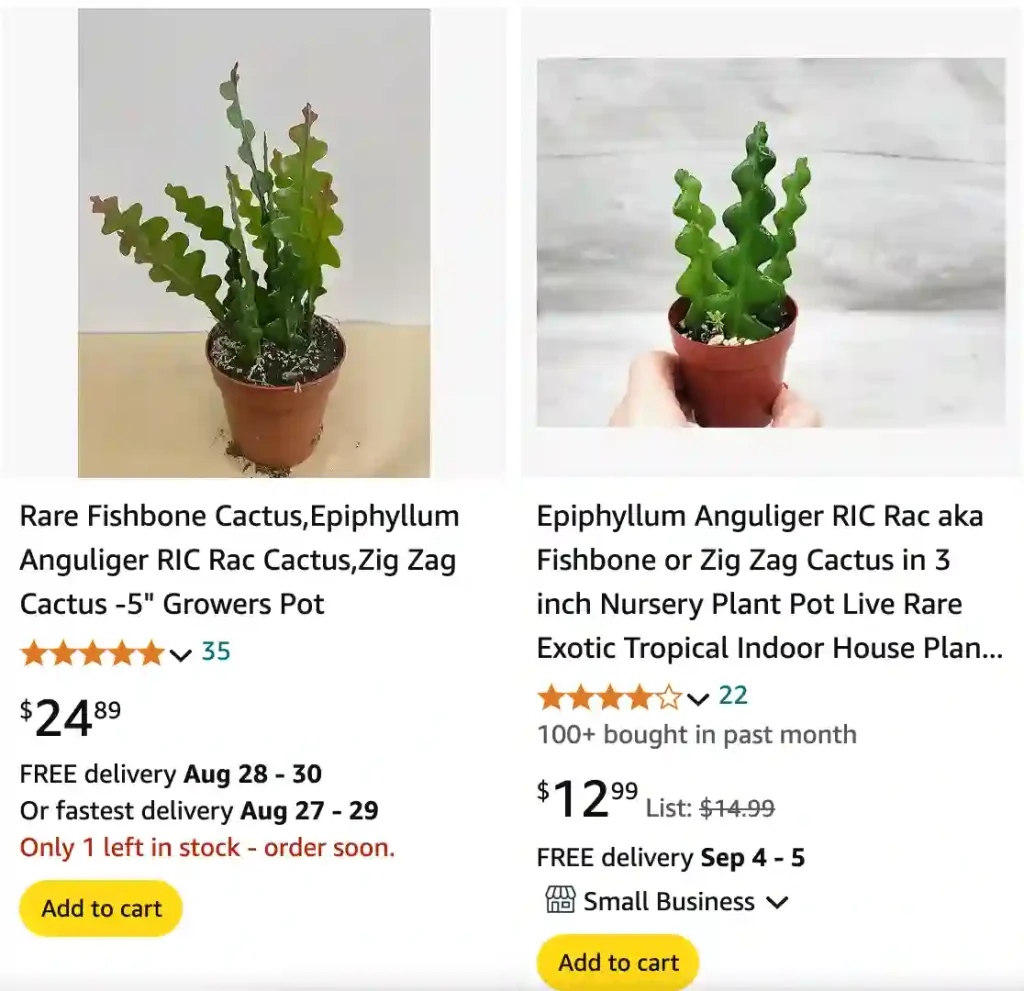
FAQs About Fishbone Cactus
As a plant enthusiast, I’ve had my fair share of interactions with the Fishbone Cactus, also known as Epiphyllum Anguliger. This quirky plant, with its zigzagged, fishbone-like stems, is a unique addition to any collection. Here are some frequently asked questions about Fishbone Cactus that I’ve come across, along with my personal insights.
10 Species in Genus Epiphyllum
How to Propagate Fishbone Cactus?
Propagating Fishbone Cactus is relatively straightforward. The best method is by using stem cuttings. Here’s how I do it:
- Choose a Healthy Stem: Select a healthy, mature stem from the plant.
- Cut the Stem: Using a sharp, sterile knife or scissors, cut a segment about 4-6 inches long.
- Let It Callous: Allow the cut end to dry and callous over for a few days to prevent rot.
- Plant the Cutting: Place the cutting in a pot with a well-draining cactus mix.
- Water Sparingly: Water lightly until new growth appears.
Propagation can be quite rewarding and is an excellent way to expand your cactus collection or share with friends.
Are Fishbone Cactus Safe for Cats?
If you’re a cat owner, you might be concerned about your furry friend’s health. The good news is that Fishbone Cactus is generally non-toxic to cats. I’ve never had any issues with my own cats nibbling on it. However, it’s always a good idea to monitor pets around plants, as some might still chew on them out of curiosity.
Does a Fishbone Cactus Bloom?
Yes, Fishbone Cactus can bloom, although it’s not an everyday occurrence. When it does bloom, it produces striking, fragrant flowers that usually open in the evening. To encourage blooming, ensure your cactus gets a period of cooler temperatures and less water in the winter, which mimics its natural dormancy period.
How Often to Water Fishbone Cactus?
Fishbone Cactus prefers to dry out between waterings. I usually water mine once every 2-3 weeks during the growing season (spring and summer) and reduce watering in the winter. Overwatering is a common mistake and can lead to root rot.
How to Care for Fishbone Cactus?
Proper care for Fishbone Cactus involves several key aspects:
- Light: It thrives in bright, indirect light. Too much direct sunlight can scorch its stems.
- Soil: Use a well-draining cactus or succulent mix.
- Temperature: It prefers temperatures between 60-75°F (15-24°C). Protect it from frost.
- Humidity: It enjoys higher humidity levels, which can be enhanced with a humidity tray.
How to Make Fishbone Cactus Bloom?
To encourage blooming, mimic the plant’s natural conditions:
- Cooler Temperature: Lower the temperature in winter to around 50-55°F (10-13°C).
- Reduced Watering: Cut back on watering during the winter months.
- Proper Light: Ensure it gets enough bright, indirect light throughout the year.
How to Prune a Fishbone Cactus?
Pruning is important to maintain the shape and health of your Fishbone Cactus. Here’s how I approach it:
- Use Clean Tools: Sterilize your pruning shears or scissors.
- Trim Dead or Overgrown Stems: Cut back any dead or overly long stems to promote new growth and keep the plant looking tidy.
- Cut at a Node: Make cuts just above a node (where a stem segment meets the main stem) to encourage branching.
How to Repot Fishbone Cactus?
Repotting is necessary every 2-3 years or when the plant outgrows its pot. Here’s my method:
- Choose a Pot: Select a pot that’s 1-2 inches larger in diameter than the current one.
- Prepare the Soil: Use a well-draining cactus mix.
- Remove the Plant: Gently take the cactus out of its old pot.
- Repot: Place it in the new pot, fill with fresh soil, and water lightly.
Is Fishbone Cactus Toxic to Dogs?
Similar to cats, Fishbone Cactus is not considered toxic to dogs. However, it’s always a good idea to keep plants out of reach of pets to avoid any potential issues.
Why is My Fishbone Cactus Turning Yellow?
Yellowing can indicate several issues:
- Overwatering: Too much water can lead to root rot and yellowing.
- Poor Drainage: Ensure your pot and soil provide good drainage.
- Nutrient Deficiency: A lack of nutrients can cause discoloration. Consider feeding with a balanced, diluted fertilizer during the growing season.
Why is My Fishbone Cactus Wrinkled?
Wrinkling usually points to a water issue:
- Underwatering: The plant might be too dry. Increase watering slightly.
- Overwatering: Conversely, too much water can also cause stress. Adjust watering practices as needed.
Are Fishbone Cactus and Ric Rac Cactus the Same?
Fishbone Cactus and Ric Rac Cactus are often confused. While they both belong to the Epiphyllum genus and have similar growth patterns, they are distinct. The Ric Rac Cactus, also known as Epiphyllum anguliger, typically has more pronounced zigzag patterns, whereas the Fishbone Cactus might have slightly less pronounced angles.
Fishbone Cactus vs Ric Rac Cactus
The main differences between Fishbone Cactus vs Ric Rac Cactus or Epiphyllum Anguliger vs Selenicereus Anthonyanus are in their growth habits and stem appearance. While both have a similar shape, the lobes of the stems of Epiphyllum Anguliger are rounded, where as the lobes of Selenicereus Anthonyanus are narrower and longer.
What to Plant With Fishbone Cactus?
Fishbone Cactus pairs well with other tropical plants, especially those that enjoy similar care conditions. Consider mixing it with other epiphytic plants like orchids or bromeliads for a lush, vibrant display.
Common Problems and Solutions
Here are a few common issues I’ve encountered:
- Rotting: Often caused by overwatering. Ensure well-draining soil and adjust watering frequency.
- Pest Infestations: Check for pests like mealybugs and treat with insecticidal soap if necessary.
In summary, the Fishbone Cactus is a resilient and fascinating plant that, with the right care, can thrive and even bloom. Its unique appearance and care requirements make it a delightful addition to any plant collection.
If i die, water my plants!



